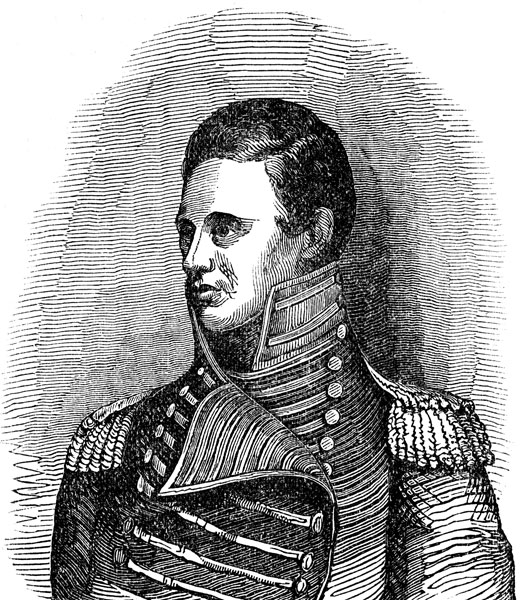Soon after the acquisition of the territory of Louisiana by the United States, expeditions were sent out by the government to explore the region west of the Mississippi. The first reliable information as to cHmate and general features of the country was from the report of the Lewis and Clark expedition in 1804-5-6.
 So far as is known, Lieut. Zebulon M. Pike was the first explorer to visit this part of Kansas. In 1806 he followed the course of the Arkansas river through this valley and his explorations embraced a larger range than any before made. The beginning of commercial intercourse with Mexico via the Santa Fe trail dates from the first publication of his journal which was published immediately after the return of Lieut. Pike.
So far as is known, Lieut. Zebulon M. Pike was the first explorer to visit this part of Kansas. In 1806 he followed the course of the Arkansas river through this valley and his explorations embraced a larger range than any before made. The beginning of commercial intercourse with Mexico via the Santa Fe trail dates from the first publication of his journal which was published immediately after the return of Lieut. Pike.
 The government also sent out Major S. H. Long on a scientific exploring expedition in 1819-1820. The reports from these expeditions were not flattering to this country. According to their opinion, most of the state of Kansas was unfit for habitation by civilized people, especially the Western portion. And on the early maps, Western Kansas was included in that great area marked "The Great American Desert". The following report was recorded by Zebulon Pike in his journal concerning this region:
The government also sent out Major S. H. Long on a scientific exploring expedition in 1819-1820. The reports from these expeditions were not flattering to this country. According to their opinion, most of the state of Kansas was unfit for habitation by civilized people, especially the Western portion. And on the early maps, Western Kansas was included in that great area marked "The Great American Desert". The following report was recorded by Zebulon Pike in his journal concerning this region:
"The border of the Arkansas river ... is the paradise of our territories for the wandering savages. ... I believe there are elk, deer and buffalo sufficient on the banks of the Arkansas river alone, if used without waste, to feed all the savages in the United States territory one century, but the region could not support white men in large numbers even along the rivers. The wood now in the country would not be sufficient for a modern share of population more than fifteen years. But possibly time may make discoveries of coal mines which would render the country habitable."
Lieut. Pike evidently did not discover the fuel value of the "buffalo ship" which lay so thickly scattered over the prairies and like the manna of old, required only to be gathered; neither did he know that the native sod could be converted into houses far more comfortable than the ones made of logs. And never did he dream of the treasure which lay buried beneath the sod, the natural gas, which is of greater value than the treasure sought for by Coronado. Nothing but time could change the minds of the people in regard to "The Desert". As the years passed, innumerable caravans of prairie schooners began moving westward, but they were in search of fairer lands and brighter fortunes, which they believed lay far beyond the so-called desert. It was a motley throng and the travel was sufficient to imprint clearcut trails across the mighty plains. Traders to Santa Fe; Mormons fleeing into the wilderness to set up their temples of worship; gold seekers to California; emigrants to Oregon; soldiers; travelers and adventurers. It is estimated that ninety thousand persons passed through Kansas in 1849-50. But of all this moving host, none drew aside to settle in this beautiful region. This was a territory occupied only by Indians, a few traders, trappers and hunters.
With the organization of Kansas Territory in 1854, came a simultaneous effort to extinguish the Indian title to the lands and thus open them to white settlers. Stealthy treaties with the various tribes began. Immigrants began settling first in the eastern part. Those who came in from the north wished to have it a free state; those from the south determined to own slaves. The result was that Kansas became a battlefield for the two opposing parties, and was known as "Bleeding Kansas". The western part of the state was scarcely disturbed by events of the rebellion. It still remained largely in the possession of the Indians. There was no attempt made to settle or develop the resources of this part of the "Great American Desert" until after the close of the Civil War; and even then there were no settlers in this region until after the building of the Atchison, Topeka & Santa Fe railroad in 1872. The records of the Department of Missouri for 1874 show the following garrisoned posts in Kansas: Fort Dodge, Fort Wallace, Fort Larned, Fort Riley and Fort Leavenworth. Summer camps were established on Wild Horse Creek and near Grinnell Station. The records also show that small detachments of the 19th Infantry were stationed at the following points, guarding railroad stations, mails, contractors, trains, etc.: Lakin, Kearny County; Cimarron, Gray County; Syracuse, Hamilton County; Bluff Creek Mail Station; Pierceville, Finney County; Sun City, Barber County; Wild Horse Station on the Kansas-Pacific Railroad; at Aubrey and at Sargent.
